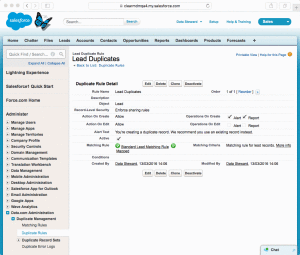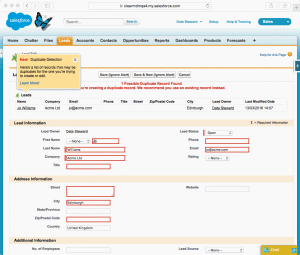As the architect of a specialist master data management AppExchange solution, I’m often asked to explain the difference between standard Salesforce features and the clearMDM product. This is a very reasonable question that warrants a complete answer. This post provides an overview of the standard Salesforce platform features related to master data management and outlines the use cases that are supported natively and those that require a specialist MDM tool such as clearMDM.
Data.com Duplicate Management
The Spring ’15 Salesforce release introduced native duplicate management under the Data.com feature set. Rather confusingly, unlike other Data.com features the duplicate management functionality requires no additional licensing. In simple terms duplicate management supports two key scenarios; protection-against and reporting-on duplicate records introduced at the point-of-entry. Matching rules can be configured that employ fuzzy matching logic and operate across objects. Duplicate rules define the required behaviour once a duplicate is identified; block, allow and report are available options. The report option allows duplicate record sets to be persisted to standard objects from which reports can be produced. Salesforce reporting subscriptions can then be used to push data stewarding reports to relevant users to introduce a light level of data management process automation. The standard objects also support Apex Trigger extensibility; this enables custom solutions to be developed of a technical nature.
As of the Spring ’16 release Data.com Duplicate Management features were configured and enabled by default in all new orgs for Account, Contact and Lead standard objects. At the time of writing (Summer ’16) support for Person Accounts remains on the roadmap.
In summary, Data.com Duplicate Management provides configurable and robust protection against the introduction of new duplicate records through the Salesforce user interface, mobile apps or API. There are no capabilities that address either duplication within an existing data set or the requirement to merge (or link) records together and perform consolidation. Single Customer View (or 360-degree) use cases that require support for automated match-merge-consolidate record-lifecycles plus tool support for data-stewarding process will require additional MDM capabilities. The clearMDM product provides a native solution to this specific type of requirement with features designed to complement and extend standard Salesforce capabilities.
Standard Merge Tool
A long-time standard capability of Salesforce has been the ability to find duplicates manually using phrase matching and to merge a limited number of records. I’m using the terminology merge tool here however the same functionality is available to both API and Apex contexts. The merge tool capability is limited to Account, Contact and Lead standard objects and supports up to 3 records within a single merge operation. Losing records are discarded, meaning deleted, there are no options to apply tagging and linking to maintain relationships from source records to master records. An additional consideration for B2C environments is that Person Accounts enabled for Portal/Community access can’t be merged. The standard merge tool does not support cross-object merge or the ability to create a new master record. Two key areas of limitation for the standard merge tool are that search is by Name field only and that search result fields are fixed. The latter limitation can be frustrating where the fields that distinguish duplicate records are not shown in the search results.
In summary, the standard merge tool provides a powerful tool for manual merge scenarios where the use case supports deletion of identified duplicates. For low-volume, ad-hoc data quality use cases the standard merge tool can provide a proven, efficient solution. Where automation or batch merge processing is required technical solutions can be developed using the standard APIs or Apex code.
clearMDM Advantages
For use cases requiring protection against new duplicates (blocking), or support for low-volume, manual duplicate elimination the standard feature set is more than sufficient. As a general rule standard platform capabilities should always be considered fully before 3rd party AppExchange, or custom solutions are introduced; this rule holds true in respect to data management. The clearMDM product exists to address more complex scenarios such as the Single Customer View where data processing is lifecycle-based, automated and support for efficient data stewarding processes is required. The product has been designed to deliver a lightweight, pragmatic master data management solution that can be configured by Salesforce administrators or business users (data stewards, data scientists etc.) with no code required.
The bullet points below summarise the key points of differentiation between clearMDM and standard Salesforce features.
- Targeted at Single Customer View and external data consolidation use cases not duplicate blocking.
- Supports automated record life-cycles (match, merge, consolidate) not ad-hoc, manual tasks.
- Point-of-entry protection plus real-time and automated matching.
- No code approach; maintainable by Salesforce administrators or business users.
- Supports data stewarding process and data governance requirements.
Mark Cane




